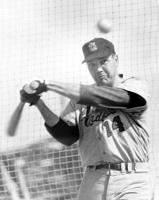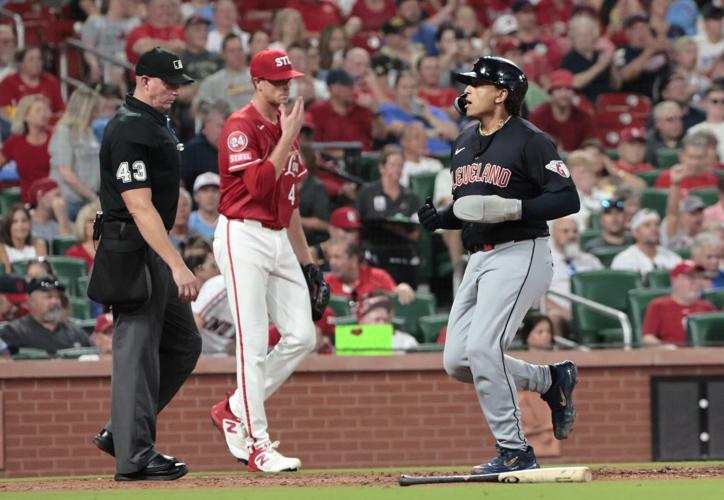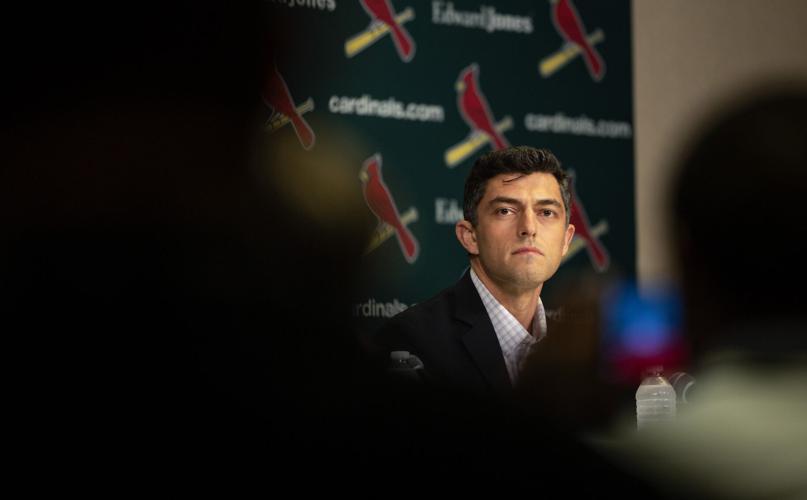
Chaim Bloom fields questions from reporters on Monday, Sept. 30, 2024, at Busch Stadium. Bloom will take over as Cardinals president of baseball operations ahead of the 2026 season.
SAN ANTONIO ŌĆö During a conversation about how ŌĆ£hypercompetitiveŌĆØ the industry has increasingly become beneath the surface of the big league standings and in the advanced arts of spending on coaches, experts, facilities and cutting-edge technology for player development, ClevelandŌĆÖs president of baseball operations brought up a club that not too long ago was a model for producing young, contending talent.
ŌĆ£From the outside looking in, some of the best, most competitive Cardinals teams are those that had guys who came through their development pipeline, through the CardinalsŌĆÖ way,ŌĆØ Chris Antonetti said Tuesday. ŌĆ£And they ended up transitioning from young amateur or international players and ended up becoming really good major league players.ŌĆØ
The Cardinals want to get back ŌĆö really, catch up ŌĆö to excelling at that.
And Antonetti has one of the best views how.
People are also reading…
As a Midwest, smaller-market team with revenues now buffeted by an abandoned broadcast contract, Cleveland won its division and reached the American League Championship Series. The Guardians succeeded with a largely homegrown roster, a keen sense for amplifying young pitchers, and a player development program ŌĆö one from which the Cardinals are plucking an executive.
This weekŌĆÖs general manager meetings at a golf resort outside of San Antonio are the first for the CardinalsŌĆÖ new executives, future president of baseball operations Chaim Bloom and Rob Cerfolio, the recent assistant general manager put in charge of development and performance. He joins the Cardinals after a decade in Cleveland, where he most recently oversaw their player development.
ŌĆ£First and foremost, an incredible teammate and a great leader,ŌĆØ Antonetti said. ŌĆ£Does an incredible job of bringing people together to surface the best ideas and then find a way to implement them effectively. Really led a lot of our recent developmental initiatives across player development.ŌĆØ
The Post-Dispatch asked if Antonetti could offer an example.
ŌĆ£Nope,ŌĆØ he said, laughing.
Bet the Cardinals know.
Bet the Cardinals want to do too.
Rival executives and some agents who have spoken with the Cardinals this week described them as in ŌĆ£a transition phaseŌĆØ coming out of a second consecutive year without a playoff berth and into the final year of John MozeliakŌĆÖs tenure as president of baseball operations. They are trimming millions from the major league payroll even as they pledge to reinvest in player development. That remains an area where smaller-market teams like the Guardians or mid-market clubs who punched above their weight like the Cardinals can find an edge on the big spenders. It is also where the Cardinals lost ground in recent years.
It was slow for the Cardinals as changes to the industry happened fast.
ŌĆ£When I left the Cardinals in 2011-12, analytics were basically statistical analysis,ŌĆØ said Orioles general manager Mike Elias, who left being a scout for the Cardinals to key roles in two rebuilds from rock bottom, in Houston and Baltimore. ŌĆ£So really, the only way it was happening in player development was, ŌĆśIs this guy good or not? Do we promote him?ŌĆÖ Things like that. It was putting statistical information in front of players, coaches and decision-makers.
ŌĆ£And then about three or four years later, we had an explosion of Trackman and tracking devices, and teams started building predictive models from all the tracking information. And then you also had a private sector of player development explosion. You could go to a pitching lab and see some of the data points and use all the new high-speed cameras. ItŌĆÖs been an absolute technology revolution. And IŌĆÖd say it started 2014-2015, and itŌĆÖs become really pervasive in the last four or five years.ŌĆØ
Elias, whose team has reached the playoffs each of the past two seasons, then listed all of the necessary spending ŌĆö cameras, radar installations, computer infrastructure, facilities at the Dominican Republic academy that could accommodate the new tech.

The GuardiansŌĆÖ Bo Naylor scores on an RBI single by Daniel Schneemann as Cardinals pitcher Kyle Gibson walks back to the mound in the fourth inning of a game on Friday, Sept, 20, 2024, at Busch Stadium.
Years of struggling yielded high draft picks the Orioles used on All-Stars Adley Rutschman and Gunnar Henderson or recent No. 1 overall Jackson Holliday. Elias said it was the development structure the Orioles had that helped Henderson rework his swing. The picks may get headlines, but the player development structure gets the results, he countered.
ŌĆ£I think itŌĆÖs been an enormous factor for us,ŌĆØ he said. ŌĆ£More than the high picks.ŌĆØ
Echoed Antonetti: ŌĆ£For us, we recognize, to be successful, we have to excel in those areas, so we spend a lot of time and energy and resources in those areas trying to create the best development environment that we can. The way in which weŌĆÖre going to build rosters are going to be guys that come from our player development. That has to be the nucleus of our team.ŌĆØ
To illustrate how competitive the development race has become for clubs, Antonetti recounted the soaring growth of staffs and the costs to fill them. He estimated when he started with Cleveland the team had eight members of the front office and around 130 people in player development, minors and scouting. Those numbers are now 50 in the front office and 240 elsewhere in baseball operations.
MinnesotaŌĆÖs president of baseball operations Derek Falvey, another team feeling the broadcast-revenue pinch, recalled his early days on the job presenting Twins ownership with a breakdown of the additions needed for player development, from staff to tech to facilities.
ŌĆ£One thing that goes underreported to some degree across our industry,ŌĆØ he said. ŌĆ£I know we focus a lot on payroll, but when I got to Minnesota I put on paper for our ownership the investment and infrastructure spending for player development, scouting, some of our R&D (research and development) spaces, major league operations. ThatŌĆÖs a real investment. It doesnŌĆÖt come out publicly in the sense that itŌĆÖs not on your payroll. But itŌĆÖs real. And itŌĆÖs a recurring investment you need to continue to add to over time.
ŌĆ£WeŌĆÖve definitely doubled our investment even over that period of time,ŌĆØ Falvey said of the past few years. ŌĆ£WeŌĆÖre not alone in that. A lot of teams have done that. WeŌĆÖre kind of keeping up.ŌĆØ
As an example, the Twins are one of the clubs with a motion-capture machine.
A few clubs have them for several levels, if not all. The Twins have two.
ŌĆ£We have to make very specific targeted investments,ŌĆØ Falvey said.
Elias noted how during the early, accelerating growth of spending on tech for modern player development, it was also competitive and difficult to find coaches comfortable using it. That pool of experts has grown. For the Cardinals, that same time period was when they had reductions in staff or did not fill some roles within the minor league system. Part of the modernizing they intend to do, and Bloom is charged with leading, is making up that ground ŌĆö with staff and with tech. They are thinking about purchasing their first motion-capture device.
ŌĆ£The main thing is you have to make sure the information is being used and used well, and that costs money in terms of people and expertise,ŌĆØ Elias said. ŌĆ£That has raised the cost of player development overall throughout the sport. But ultimately you think there is some (return on investment). You have more young players that youŌĆÖre able to enjoy before they reach free agency. It seems like it pays off.ŌĆØ
For the Cardinals, the goal goes beyond young players before they become free agents ŌĆö itŌĆÖs about getting back to developing impact players they can debut and then use a financial edge on similarly sized markets to keep into their free-agent years.
A few weeks after the big-spending Yankees lost to the bigger-spending Dodgers in the World Series, Falvey agreed with the premise that the gap between large and small market teams is narrower when it comes to spending on player development.
He was asked if that remains a place where $1 invested can yield production worth $10.
ŌĆ£ThatŌĆÖs a really good way to put it,ŌĆØ he said. ŌĆ£And from where I sit there are some areas pretty clearly where, in my mind, the investment off the field in the development strategy or plan is ultimately going to yield more than that same dollar in free agency. We need to always think about how do we get the best bang for our buck.ŌĆØ
That becomes even more vital if the broadcast bucks shrink.
Minnesota has already had a full year of that, and the Twins scaled back spending on the payroll by more than $20 million. Its rights contract negated midstream, Cleveland is entering its first year as an MLB Media team with those reduced revenues. The Cardinals could be a year away from doing the same ŌĆö if not sooner. Getting back to homegrown roots is retro for the Cardinals, but how itŌĆÖs done these days is new. No wonder, as they pull back to focus on retooling, theyŌĆÖre pulling from another clubŌĆÖs front office for guidance.
The expectations even sound familiar.
ŌĆ£I want to be clear: Our goal is no different,ŌĆØ Cleveland executive Antonetti said. ŌĆ£We want to field a competitive team that is capable of winning our division, making it to the postseason, and then finding a way to win that last game. Regardless of what the other circumstances are, that does not change. ... In the end, no one cares about what our payroll is. They care about how many wins did we get? Did we advance in the postseason? Did we win a World Series?ŌĆØ

















